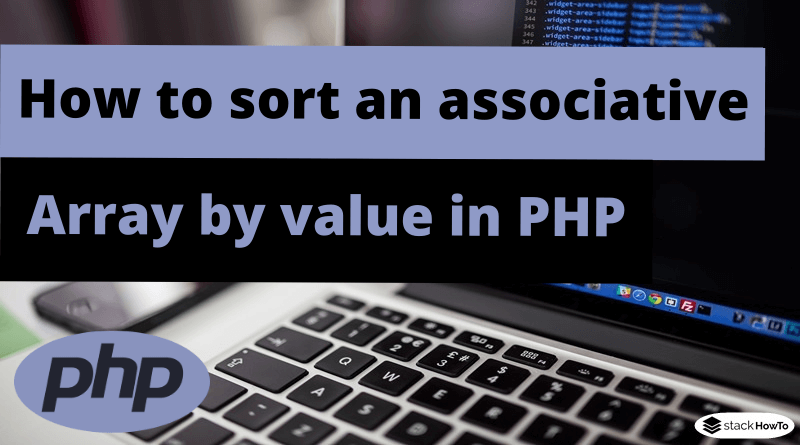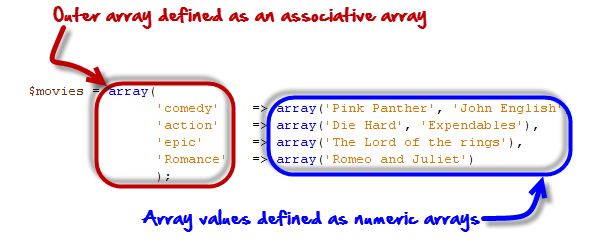
Maps also exist in JavaScript and therefor we could also cast our JSON response to a map by simply using Object.entries: // Data from our APIĬonst map = new Map(Object. A PHP associative array refers to the concept of storing the information in key and value. For example, if you have an array of 10 elements then the first index will be zero and the last index will be nine. MapsĪs mentioned in the beginning many languages implement associative arrays in form of maps (or lists, or whatever you want to call them). It shows that the last index will be equal to the number of array elements minus one. You can also use the PHP foreach loop or PHP for loop to access the elements of an associative array. The short answer is: use the index operator ( ) and pass the element key as the argument.
Php associative array index how to#
$data = ĭata.substr(0, 5) // error: `substr` does not exist on numbers! Thanks to the generic it's easy to tell what's inside our array. This is used mainly when sorting associative arrays where the actual element order is significant. < > In this tutorial, learn how to get elements of an associative array in PHP.not specifying `T` means that the type remains unknownĭata.toFixed() // error: `toFixed` does not exist on strings! This may sound a bit complicated, but if we're looking at an example again everything should be clear (assuming getData retrieves data from our API): // $data = Ĭonst data: AssociativeArray = getData() This union type tells TypeScript that we're either dealing with an object consisting of key-value pairs, where key is a string and the value is of type T, or a simple array with elements of T (which also includes empty arrays). Becomes | T T could eventually be omitted, but provides additional type information for our arrays. Let's take a look at what happens to associative arrays within JSON responses.

And, even if associative arrays in PHP are possible (and heavily used), they can get a bit confusing as soon as you want to work with them in your JSON API. Or you could use an ArrayIterator.The concept of associative arrays in PHP is kinda uncommon most languages implement this concept with maps, lists, dictionaries or similar constructs. This would create an array holding only the element at the third position. If you want to extract elements from an array by offset, you have to use $third = array_splice($array, 2, 1) Instead, you can use the employees' names as keys in an associative list, with their salaries as the value. A numerically indexed array is not the best option for storing employee salaries in an array. Which means the element at offset 0 is foo although it's key is 100. The index of an associative array is a string that allows you to create a strong link between key and value.

The Offset of an element is completely unrelated to it's key or value print_r( But if you wanted to access the second associative value in that array ( 'some'), you cannot do $array] because that would evaluate to $array and that's baz. Using the unset() function, you can remove a specific element of an indexed or associative PHP array by specifying its index or key respectively. Not just simple indexed arrays, examples to print associative arrays, and multi-dimensional arrays are also included in this guide. There are two ways to create an associative array: age array(Peter>35, Ben. The short answer is: use the index operator ( ) and pass the element key as the argument. 1- using for loop 2- using foreach loop 3- use echo statement 4- using printr () function 5- using vardump () function 6- using varexport () function Also, you will learn each method with an example. So when you do $array] you are really doing $array. Associative arrays are arrays that use named keys that you assign to them. Likewise, for a mixed array like shown above, the solution with array_keys suggested elsewhere on this site will not work, because print_r( array_keys(array('foo', 'foo' => 'bar', 'baz', 'some' => 'value')) ) values Syntax 'index > values', separated by commas, define index and values. It is wrong to assume that just because foo is the first associative key it has anything to do with the actual numeric key 1. The name makes sense if you imagine associating each.

As you can see, in that array above, index 1 is associated with baz. When you take control of the indexes, or keys, of an array, the array is known as an associative array. That's the offset, but it has nothing to do with the index 1. The foo is the second element in the array. When you say you want to set the value of an associative array using the array index of the key/value, then you have to use the given key, setting $array is not the same as setting $array.Ĭonsider this array print_r( array('foo', 'foo' => 'bar', 'baz', 'some' => 'value') )

There is no correlation between numeric and associative index keys.


 0 kommentar(er)
0 kommentar(er)
